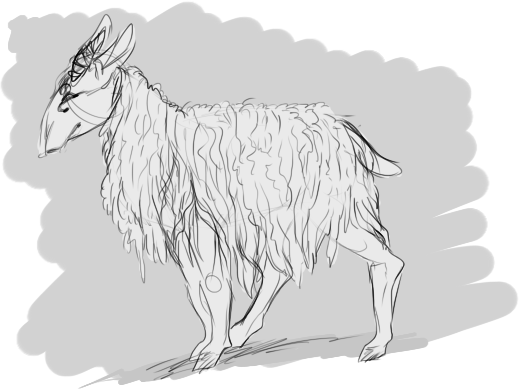Saeka
The reason saekas live on the steppe is that if they lived in mountainous regions, they would walk off a ledge.
Saekas are one of the most widespread domestic animals across the Taalorang Steppe. For generations, Baan people have herded them in circuits around the grassy expanse.
Saeka have an important place in Baan culture. Shepherds take care of their flocks with patience and dedication, although there is a persistent feeling of frustration because they are not very bright animals. Shepherds often joke with each other about how useless and death-prone their saeka are and how they're this close to selling the lot and moving to Temru. But, those same shepherds are the ones who will walk through a storm to find a lost saeka out on the plains.
Saeka are the most common source of milk in Taalora. They use the milk to make yoghurt and cheese, drink it raw, or let it ferment for an alcoholic drink. Saeka were bred to have thick, woolly coats that are sheered every spring. The wool is used for clothing and blankets. The final use is meat, as saeka meat is a staple of their diets.
Saeka have an important place in Baan culture. Shepherds take care of their flocks with patience and dedication, although there is a persistent feeling of frustration because they are not very bright animals. Shepherds often joke with each other about how useless and death-prone their saeka are and how they're this close to selling the lot and moving to Temru. But, those same shepherds are the ones who will walk through a storm to find a lost saeka out on the plains.
Saeka are the most common source of milk in Taalora. They use the milk to make yoghurt and cheese, drink it raw, or let it ferment for an alcoholic drink. Saeka were bred to have thick, woolly coats that are sheered every spring. The wool is used for clothing and blankets. The final use is meat, as saeka meat is a staple of their diets.
Basic Information
Dietary Needs and Habits
Saekas are grazers. They primarily eat grass and spend most of the day standing around herds, grazing in the field.

Saeka by Lex
Lifespan
18 - 20 years
Average Height
2' at the shoulder
Average Weight
60 lbs
Body Tint, Colouring and Marking
Wool tends to be light beige to white, occasionally with a reddish hue


